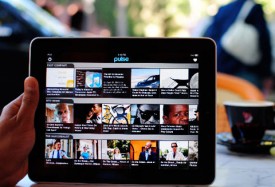[Every Friday, Mark Coddington sums up the week’s top stories about the future of news and the debates that grew up around them. —Josh]
![]() The Times has the Pulse (briefly) pulled: Last week, I noted one of the more interesting iPad news apps: Pulse News Reader, designed by two Stanford grad students, is a stylish news aggregator. But on Monday, the app was pulled from the iTunes store based on a claim that it infringes on The New York Times’ copyright after some Times folks saw the paper’s own blog post about the reader. The app was reinstated the next day, but the debate over copyright, aggregation, and mobile apps had already taken off.
The Times has the Pulse (briefly) pulled: Last week, I noted one of the more interesting iPad news apps: Pulse News Reader, designed by two Stanford grad students, is a stylish news aggregator. But on Monday, the app was pulled from the iTunes store based on a claim that it infringes on The New York Times’ copyright after some Times folks saw the paper’s own blog post about the reader. The app was reinstated the next day, but the debate over copyright, aggregation, and mobile apps had already taken off.
The central point of the Times’ argument was that the $3.99 app was an illegal attempt to make money off of the Times’ (and The Boston Globe’s) free, publicly available RSS feeds. (The paper also objected to app’s placement of the Times’ content within a frame on the iPad.) The Citizen Media Law Project’s Kimberley Isbell helpfully broke down the Times’ claims and the Pulse Reader’s possible fair-use defenses, noting the Times articles’ free accessibility and the relatively small article portions displayed on the reader.
 Reaction on the web weighed overwhelmingly against the Times: Wired contended that every piece of paid software used to access the Times’ site would be outlawed by the paper’s logic, while Techdirt’s Mike Masnick argued that Pulse was selling its software, not the Times’ feeds. GigaOm’s Mathew Ingram wondered whether the Times was declaring war on news aggregators, and the Sydney Morning Herald reasoned that if the Times is offering its RSS for free, it can’t complain when someone designs a reader to view it. Blogging and RSS vet Dave Winer had the harshest response in a post arguing that the Times is in the business of news production, not distribution: “Look, if the Times is depending on stopping those two kids for its future, then the Times has no future.”
Reaction on the web weighed overwhelmingly against the Times: Wired contended that every piece of paid software used to access the Times’ site would be outlawed by the paper’s logic, while Techdirt’s Mike Masnick argued that Pulse was selling its software, not the Times’ feeds. GigaOm’s Mathew Ingram wondered whether the Times was declaring war on news aggregators, and the Sydney Morning Herald reasoned that if the Times is offering its RSS for free, it can’t complain when someone designs a reader to view it. Blogging and RSS vet Dave Winer had the harshest response in a post arguing that the Times is in the business of news production, not distribution: “Look, if the Times is depending on stopping those two kids for its future, then the Times has no future.”
The app’s creators were just as baffled as anybody about why the app was reinstated, a Times’ spokesman apparently tried to pass off the complaint as a mistake, though that response doesn’t exactly square with the Times’ Martin Nisenholtz’s reiteration of the paper’s case to paidContent’s Staci Kramer. As for whether this claim would apply beyond the Pulse Reader, Nisenholtz said it would be handled “on a case by case basis.”
We had plenty of other iPad news this week, too — Jobs made a number of mostly iPhone-related announcements at Apple’s developers’ conference on Monday, and the Lab’s Joshua Benton explained what they mean for mobile news. A few highlights: Apple’s not providing much clarity about recent app-banning controversies, but it is moving decisively on ebooks and its iAd mobile advertising platform. The AP reported that publishers are seeing encouraging early signs about wringing advertising dollars out of the iPad, but Ken Doctor went on a wonderful little rant against publishers that are slow to take advantage of the iPad’s capabilities. Meanwhile, the Wall Street Journal’s Robert Thomson slammed news orgs’ repurposed “crapps” and talked, with the Journal’s Les Hinton, about his paper’s own iPad strategy. And the iPad faced its first major security issue, as the email addresses of at least 114,000 owners were exposed by hackers.
 The purpose of the link: A Nicholas Carr post last week ignited a spirited discussion about the relative values of the link, and that conversation continued this week with twin Wall Street Journal columns by Carr and web scholar Clay Shirky debating whether the Internet makes us smarter. Carr said no, using a similar argument to the one he laid out in his earlier post (it’s also the central point of his new book): The Internet encourages multitasking and bite-size information, making us all “scattered and superficial thinkers.” Shirky said yes, arguing that the Internet enables never-before-experienced publishing and connective capabilities that allow us to put our cognitive surplus to work for a better society. (That’s also the central point of his new book.) Quite a few people, led by GigaOm’s Mathew Ingram, posited that both writers were right – Carr in the short term, Shirky in the long term.
The purpose of the link: A Nicholas Carr post last week ignited a spirited discussion about the relative values of the link, and that conversation continued this week with twin Wall Street Journal columns by Carr and web scholar Clay Shirky debating whether the Internet makes us smarter. Carr said no, using a similar argument to the one he laid out in his earlier post (it’s also the central point of his new book): The Internet encourages multitasking and bite-size information, making us all “scattered and superficial thinkers.” Shirky said yes, arguing that the Internet enables never-before-experienced publishing and connective capabilities that allow us to put our cognitive surplus to work for a better society. (That’s also the central point of his new book.) Quite a few people, led by GigaOm’s Mathew Ingram, posited that both writers were right – Carr in the short term, Shirky in the long term.
Here at the Lab, Jason Fry weighed in on the delinkification debate, giving a useful classification of the link’s primary purposes — credibility, readability and connectivity. Credibility has become a vital function in today’s web, Fry said, though he conceded Carr’s point that the link adds to the cognitive load when it comes to readability. Based on Carr’s original post, the web design firm Arc90 added an option to its browser extension to convert hyperlinks to footnotes.
The Lab also ran a fantastic three-part series on links by Jonathan Stray exploring four journalistic purposes of the hyperlink (it’s essential, he says), examining the way news organizations talk about links (they’re a bit muddled) and studying how much those news organizations actually link (not a whole lot, especially the wire services). It’s a tremendously helpful resource for anyone interested in looking at how linking and journalism intersect.
 Debate over Newsweek’s bidders: We found out about three bidders for Newsweek last Thursday, so last Friday was the time for profiles and commentary, much of it centered on the conservative news site and magazine Newsmax. Newsmax’s CEO, Christopher Ruddy, told the Washington Post that it has a number of non-conservative media projects, so Newsweek wouldn’t have to adopt a conservative viewpoint to be part of Newsmax’s plans. “Newsmax’s success is in its business model, not just its editorial approach,” Ruddy said. Newsweek employees were worried about the prospect of a Newsmax-owned Newsweek, but the New York Times’ Ross Douthat, himself a conservative, said Newsmax’s influence could be just the nudge Newsweek needs to hit its sweet spot in America’s heartland. Chicago magazine profiled another bidder, venture capitalist Thane Ritchie, while the Washington Post reported that audio equipment exec Sidney Harman is considering a bid, too.
Debate over Newsweek’s bidders: We found out about three bidders for Newsweek last Thursday, so last Friday was the time for profiles and commentary, much of it centered on the conservative news site and magazine Newsmax. Newsmax’s CEO, Christopher Ruddy, told the Washington Post that it has a number of non-conservative media projects, so Newsweek wouldn’t have to adopt a conservative viewpoint to be part of Newsmax’s plans. “Newsmax’s success is in its business model, not just its editorial approach,” Ruddy said. Newsweek employees were worried about the prospect of a Newsmax-owned Newsweek, but the New York Times’ Ross Douthat, himself a conservative, said Newsmax’s influence could be just the nudge Newsweek needs to hit its sweet spot in America’s heartland. Chicago magazine profiled another bidder, venture capitalist Thane Ritchie, while the Washington Post reported that audio equipment exec Sidney Harman is considering a bid, too.
Washington Post media critic Howard Kurtz devoted a column to the publicly acknowledged bidders, exploring the question of why no major players have emerged as bidders and concluding that the lack of interest “amounts to a no-confidence vote not just on the category of newsweeklies, which have long been squeezed between daily papers and in-depth monthlies, but on print journalism itself.” Newsweek, via its Tumblr, ripped apart the work of its Washington Post Co. colleague, taking to task for a lack of evidence and disputing his claim that the re-envisioned Newsweek is a flop. (That Tumblr is written by Newsweek social-media guru Mark Coatney, who got a New York Daily Intel Q&A a couple of days later.) Meanwhile, New York Times columnist David Carr proposed eight ways to revive Newsweek.
A sports blog network goes local: ESPN has been making a well-documented and initially successful local sports media play over the past year, but this week, a very different sports media company is making a push into what used to be local newspapers’ territory. SB Nation, a network of more than 250 fan-run sports blogs founded in 2003 by Tyler Bleszinski and Daily Kos’ Markos Moulitsas Zuniga, began rolling out 20 city-specific sports media hubs. Until now, the company has focused on team-specific (or sport-specific, in the case of some less prominent sports) blogs, but the new sites will aggregate real-time sports news mixed with fan-generated conversation and commentary.
![]() In a New York Times feature, SB Nation’s Jim Bankoff said that while his company is trying to provide a ground-up alternative to traditional sports coverage, he’d be happy to collaborate with local newspapers. Former ESPN.com columnist Dan Shanoff echoed that perspective, saying that SB Nation’s brand of sharp fan analysis is ripe for media partnerships because “it is something that local newspapers and local cable-sports networks can’t or won’t do well.” Shanoff proposed that SB Nation become a piece of a larger media company’s local media strategy, suggesting Comcast as an ideal fit.
In a New York Times feature, SB Nation’s Jim Bankoff said that while his company is trying to provide a ground-up alternative to traditional sports coverage, he’d be happy to collaborate with local newspapers. Former ESPN.com columnist Dan Shanoff echoed that perspective, saying that SB Nation’s brand of sharp fan analysis is ripe for media partnerships because “it is something that local newspapers and local cable-sports networks can’t or won’t do well.” Shanoff proposed that SB Nation become a piece of a larger media company’s local media strategy, suggesting Comcast as an ideal fit.
Here at the Lab, Bankoff gave Laura McGann a handful of lessons media organizations could learn from the SB Nation model, including tightly focused subject matter and maximizing repeat visitors. SB Nation’s team-specific focus seems to be a major component in its success, and could have some ready implications for news organizations, as Bankoff noted: “We’re not fans of sports — we’re fans of teams. We’re not fans of television. We’re fans of shows.”
Reading roundup: This week, I’ve got two news items, a few interesting pieces of commentary and one set of tips.
— Advertising Age reported that AOL is planning to hire hundreds of journalists for a major expansion into news production. At the local media blog Lost Remote, Cory Bergman, who owns a local news network himself, noted that AOL’s hyperlocal outfit Patch is making 300 of those hires and wondered what it will mean for local news.
— Los Angeles Times media writer James Rainey wrote a piece on the Las Vegas Review-Journal, a newspaper that has poured legal resources into stopping people who use its content without permission. The Times’ Mark Milian also provided a quick guide to what’s OK and what’s not when reposting.
— Publish2’s Scott Karp wrote an intriguing essay on the concept of a “content graph,” in which media organizations collaborate through distribution to enhance their brand’s value.
— News business guru Alan Mutter sensed a theme among news startups — too much focus on news, not enough on business — and wrote a stiff wakeup call.
— Two journalism/tech folks, Jeff Sonderman and Michelle Minkoff, wrote a bit about what journalism school is — and isn’t — good for. Both are worthwhile reads.
— Finally, British journalism David Higgerson has 10 ideas for building good hyperlocal websites. Most of his (very practical) ideas are useful not just for hyperlocal journalism, but for online news in general.